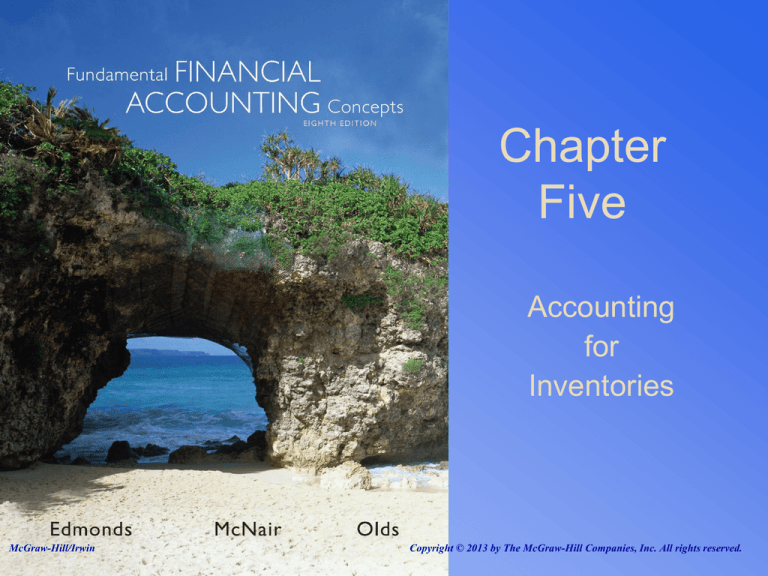
Chapter
Five
Accounting
for
Inventories
McGraw-Hill/Irwin
McGraw-Hill/Irwin
Copyright © 2013 by The McGraw-Hill Companies, Inc. All rights reserved.
Specific Identification
When a company’s
inventory consists of
many high-priced,
low-turnover goods
the record keeping
necessary to use
specific identification
is more practical.
5-1
First-in, First-out
The first-in, first-out
cost flow method
requires that the cost
of the items
purchased first be
assigned to Cost of
Goods Sold.
5-2
Last-in, First-out
The last-in, first-out
cost flow method
requires that the cost
of the items
purchased last be
assigned to Cost of
Goods Sold.
5-3
Weighted Average
The weighted average
cost flow method
assigns the average
cost of the items
available to Cost of
Goods Sold.
5-4
Physical Flow
Our discussions about
inventory cost flow
methods pertain to the
flow of costs through the
accounting records, not
the actual physical flow
of goods.
Cost flows can be done on
a different basis than
physical flow.
5-5
Effect of Cost Flow on Income
Statement
The cost flow method a company uses can
significantly affect the gross margin
reported in the income statement.
Weighted
FIFO
LIFO
Average
Sales
$ 120 $ 120 $
120
Cost of Goods Sold
100
110
105
Gross Margin
$
20 $
10 $
15
5-6
Effect of Cost Flow on Balance
Sheet
Since total product costs are allocated
between costs of goods sold and ending
inventory, the cost flow method used affects
its balance sheet as well.
Ending Inventory
Weighted
FIFO
LIFO
Average
$ 110 $ 100 $
105
5-7
Inventory Cost Flow Under a Perpetual
System
TMBC Inventory
Jan. 1
Goods Available for Sale
Beginning Inventory 10 units at $200 =
Mar. 18 First purchase
Aug. 21 Second purchase
20 units @ $220
=25 units @ $250
=
Total cost of 55 bikes (goods) available for sale
$2,000
$4,400
$6,250
$12,650
Sold 43 bikes for $350 each
First-in,
First-Out
(FIFO)
Last-in, FirstOut (LIFO)
Weighted
Average
5-8
First-in, First-out Inventory Cost
Flow
FIFO Cost of Goods Sold
Jan. 1
Beginning inventory 10 units @ $ 200 = $ 2,000
Mar. 18 First purchase
20 units @ $ 220 = 4,400
Aug. 21 Second purchase
13 units @ $ 250 = 3,250
Total cost of the 43 bikes sold
$ 9,650
5-9
Last-in, First-out Inventory Cost
Flow
LIFO Cost of Goods Sold
Aug. 21 Second purchase
25 units @ $ 250 = $ 6,250
Mar. 18 First purchase
18 units @ $ 220 =
3,960
Total cost of the 43 bikes sold
$ 10,210
5-10
Weighted Average Inventory
Cost Flow
Weighted Average Cost of Goods Sold
Total cost of the 43 bikes sold 43 units @ $ 230 = $ 9,890
Total Cost
$12,650
=
= $230
Total Number
55
5-11
Comparative Financial Statements
and the Impact of Income Taxes
5-12
Lower of Cost or Market (LCM)
Inventory must be reported at lower of cost
or market.
Market is defined
as current
replacement cost
(not sales price).
Consistent with
the conservatism
principle.
Applied three ways:
(1) separately to each
individual item.
(2) to major classes or
categories of
assets.
(3) to the whole
inventory.
5-13
5-14
If Ending Inventory is overstated then
Cost of Goods Sold will be understated.
5-15
If Cost of Goods Sold is understated,
then Gross Margin is overstated.
Resulting in overstatement
of Net Income.
5-16
Then, on the balance sheet Inventory is
overstated and Retained Earnings is overstated.
5-17
The Gross Margin Method
Calculate the expected gross margin
ratio using prior period’s income
statement.
Multiply the expected gross margin ratio
by the current period’s sales to estimate
the amount of gross margin.
Subtract the estimated gross margin
from sales to estimate cost of goods
sold.
Subtract the estimated cost of goods
sold from the amount of goods available
for sale to estimate the ending inventory.
5-18
Inventory Turnover
This measures how quickly a company
sells its merchandise inventory.
Cost of Goods Sold
Inventory
This is the first step in calculating
the average number of days to sell
inventory.
5-19
Average Number of Days to Sell
Inventory
This measures how many days, on
average, it takes to sell inventory.
365
Inventory Turnover
Other things being equal, the
company with the lower average
number of days to sell inventory is
doing better.
5-20
End of Chapter Five
5-21






